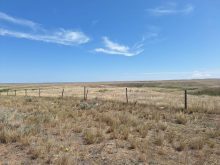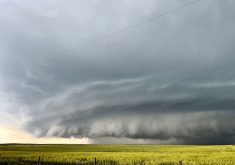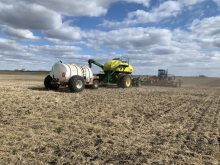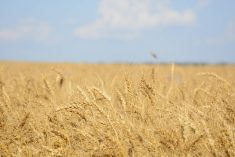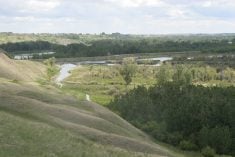Persistent rain across Western Canada is prompting concerns that prairie farmers will add to a glut of low quality milling wheat that is already weighing on world markets.
The good news, at least for some, is that volumes of top quality, high protein milling wheat could be in short supply and are likely to command price premiums from grain handlers that may be looking for blending opportunities.
“Overall, in Alberta, I think we’re going to see high volumes,” said Kevin Auch, a wheat producer from Carmangay, Alta., and chair of the Alberta Wheat Commission.
Read Also

Farming Smarter receives financial boost from Alberta government for potato research
Farming Smarter near Lethbridge got a boost to its research equipment, thanks to the Alberta government’s increase in funding for research associations.
“We’re looking for good yields, but quality-wise, if this weather keeps up, that’s going to start deteriorating pretty quickly here.”
Precipitation maps from across the West show most areas received above-average rainfall last month, with many areas receiving double or triple their normal accumulations for the month of July.
Lentil yields have taken a huge hit across much of southern Saskatchewan with significant acres unlikely to produce anything that’s worth harvesting.
Saskatchewan producers planted record lentil acreage this spring, but volumes of top quality lentils are likely to be limited because of disease and flooding.
Wheat crops are better equipped to cope with high rainfall, but disease concerns are widespread and downgrades due to bleaching and lodging and other factors are already a distinct possibility.
Bleaching has already affected winter wheat quality in south-central Alberta.
Spring wheat, which is usually harvested a bit later, could also be subject to downgrades, particularly if rain continues to fall across the province.
“We’re probably going to see quite a bit of low protein wheat this year, just because of the high moisture,” said Auch.
“But I think that’s the trend pretty well everywhere in North America this year, where we’ll see high yields and low protein.”
Auch said farmers who have high quality milling wheat with good protein values should see price premiums this year.
“If you do have high protein as a farmer, I’m thinking you will see those protein premiums come back this year.”
In Saskatchewan, SaskWheat chair Bill Gehl said frequent rain is causing headaches across most of the province. Most growers have excess moisture and many are anticipating a sloppy harvest.
In addition to potential difficulties getting machines into fields and grain out, there is a strong likelihood that many of the cereals that come off will require conditioning and close monitoring during storage.
Yield potential for much of the province’s wheat acreage is “good to excellent,” Gehl said.
“It’s probably a bit early to say, but certainly it does look … good (in terms of yield). Until you get into the combine, it’s hard to say where the quality’s going to be.”
Gehl said wheat producers across much of central Saskatchewan are looking at yields that are potentially well above average.
Localized flooding is expected to cause harvest delays and crop losses in some areas.
Gehl said he’s heard anecdotal reports that some Saskatchewan farms have received more than 1,000 millimetres of rain this growing season. For some, the damage is already mounting, but for others there is still hope for a good harvest with top grades.
“The crops are still utilizing … a lot of moisture, so they still have the ability to take up a lot of that rainfall over the next couple of weeks,” he said. “A couple of weeks with nice warm weather and some wind … can make a big difference here on the Prairies, so it’s certainly not time to hit any panic buttons.”
Big yields rarely come hand in hand with high protein levels, but Western Canada is a big area, he added.
“There will be areas that produce decent protein.”
Daryl Beswitherick, a wheat quality expert with the Canadian Grain Commission, said conditions this summer have been favourable for fusarium, but until harvest begins it’s hard to say what quality challenges might arise.
As of early August, the CGC’s harvest sample program had not received any submissions from western Canadian growers, he said.
The commission is hoping that more farmers will participate in the program this year.
Farmers who sign up and submit wheat samples receive a free grade and protein analysis.
“It’s just a bit early to say anything on crop quality yet,” Beswitherick said. “In a few weeks, we’ll have a better idea.”







